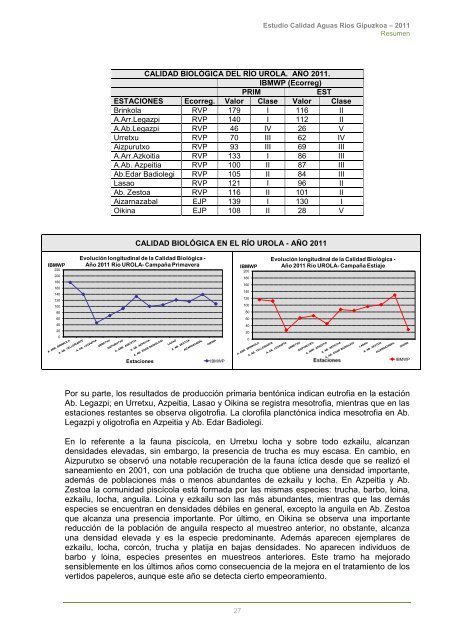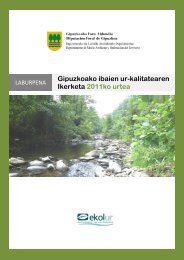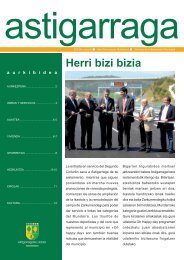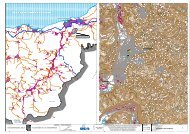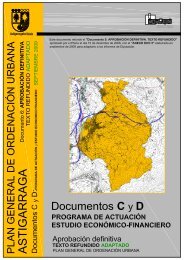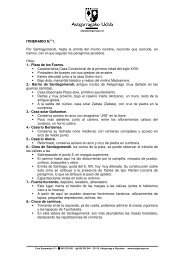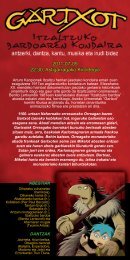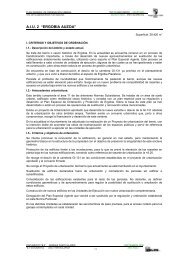Estudio de la calidad del agua de los rÃos de Gipuzkoa
Estudio de la calidad del agua de los rÃos de Gipuzkoa
Estudio de la calidad del agua de los rÃos de Gipuzkoa
- No tags were found...
You also want an ePaper? Increase the reach of your titles
YUMPU automatically turns print PDFs into web optimized ePapers that Google loves.
<strong>Estudio</strong> Calidad Aguas Ríos <strong>Gipuzkoa</strong> – 2011<br />
Resumen<br />
CALIDAD BIOLÓGICA DEL RÍO UROLA. AÑO 2011.<br />
IBMWP (Ecorreg)<br />
PRIM<br />
EST<br />
ESTACIONES Ecorreg. Valor C<strong>la</strong>se Valor C<strong>la</strong>se<br />
Brinko<strong>la</strong> RVP 179 I 116 II<br />
A.Arr.Legazpi RVP 140 I 112 II<br />
A.Ab.Legazpi RVP 46 IV 26 V<br />
Urretxu RVP 70 III 62 IV<br />
Aizpurutxo RVP 93 III 69 III<br />
A.Arr.Azkoitia RVP 133 I 86 III<br />
A.Ab. Azpeitia RVP 100 II 87 III<br />
Ab.Edar Badiolegi RVP 105 II 84 III<br />
Lasao RVP 121 I 96 II<br />
Ab. Zestoa RVP 116 II 101 II<br />
Aizarnazabal EJP 139 I 130 I<br />
Oikina EJP 108 II 28 V<br />
CALIDAD BIOLÓGICA EN EL RÍO UROLA - AÑO 2011<br />
IBMWP<br />
220<br />
200<br />
180<br />
160<br />
140<br />
120<br />
100<br />
80<br />
Evolución longitudinal <strong>de</strong> <strong>la</strong> Calidad Biológica -<br />
Año 2011 Río UROLA- Campaña Primavera<br />
IBMWP<br />
200<br />
180<br />
160<br />
140<br />
120<br />
100<br />
80<br />
Evolución longitudinal <strong>de</strong> <strong>la</strong> Calidad Biológica -<br />
Año 2011 Río UROLA- Campaña Estiaje<br />
60<br />
40<br />
20<br />
0<br />
60<br />
40<br />
20<br />
0<br />
Estaciones<br />
IBMWP<br />
IBMWP<br />
Por su parte, <strong>los</strong> resultados <strong>de</strong> producción primaria bentónica indican eutrofia en <strong>la</strong> estación<br />
Ab. Legazpi; en Urretxu, Azpeitia, Lasao y Oikina se registra mesotrofia, mientras que en <strong>la</strong>s<br />
estaciones restantes se observa oligotrofia. La clorofi<strong>la</strong> p<strong>la</strong>nctónica indica mesotrofia en Ab.<br />
Legazpi y oligotrofia en Azpeitia y Ab. Edar Badiolegi.<br />
En lo referente a <strong>la</strong> fauna piscíco<strong>la</strong>, en Urretxu locha y sobre todo ezkailu, alcanzan<br />
<strong>de</strong>nsida<strong>de</strong>s elevadas, sin embargo, <strong>la</strong> presencia <strong>de</strong> trucha es muy escasa. En cambio, en<br />
Aizpurutxo se observó una notable recuperación <strong>de</strong> <strong>la</strong> fauna íctica <strong>de</strong>s<strong>de</strong> que se realizó el<br />
saneamiento en 2001, con una pob<strong>la</strong>ción <strong>de</strong> trucha que obtiene una <strong>de</strong>nsidad importante,<br />
a<strong>de</strong>más <strong>de</strong> pob<strong>la</strong>ciones más o menos abundantes <strong>de</strong> ezkailu y locha. En Azpeitia y Ab.<br />
Zestoa <strong>la</strong> comunidad piscíco<strong>la</strong> está formada por <strong>la</strong>s mismas especies: trucha, barbo, loina,<br />
ezkailu, locha, angui<strong>la</strong>. Loina y ezkailu son <strong>la</strong>s más abundantes, mientras que <strong>la</strong>s <strong>de</strong>más<br />
especies se encuentran en <strong>de</strong>nsida<strong>de</strong>s débiles en general, excepto <strong>la</strong> angui<strong>la</strong> en Ab. Zestoa<br />
que alcanza una presencia importante. Por último, en Oikina se observa una importante<br />
reducción <strong>de</strong> <strong>la</strong> pob<strong>la</strong>ción <strong>de</strong> angui<strong>la</strong> respecto al muestreo anterior, no obstante, alcanza<br />
una <strong>de</strong>nsidad elevada y es <strong>la</strong> especie predominante. A<strong>de</strong>más aparecen ejemp<strong>la</strong>res <strong>de</strong><br />
ezkailu, locha, corcón, trucha y p<strong>la</strong>tija en bajas <strong>de</strong>nsida<strong>de</strong>s. No aparecen individuos <strong>de</strong><br />
barbo y loina, especies presentes en muestreos anteriores. Este tramo ha mejorado<br />
sensiblemente en <strong>los</strong> últimos años como consecuencia <strong>de</strong> <strong>la</strong> mejora en el tratamiento <strong>de</strong> <strong>los</strong><br />
vertidos papeleros, aunque este año se <strong>de</strong>tecta cierto empeoramiento.<br />
27


